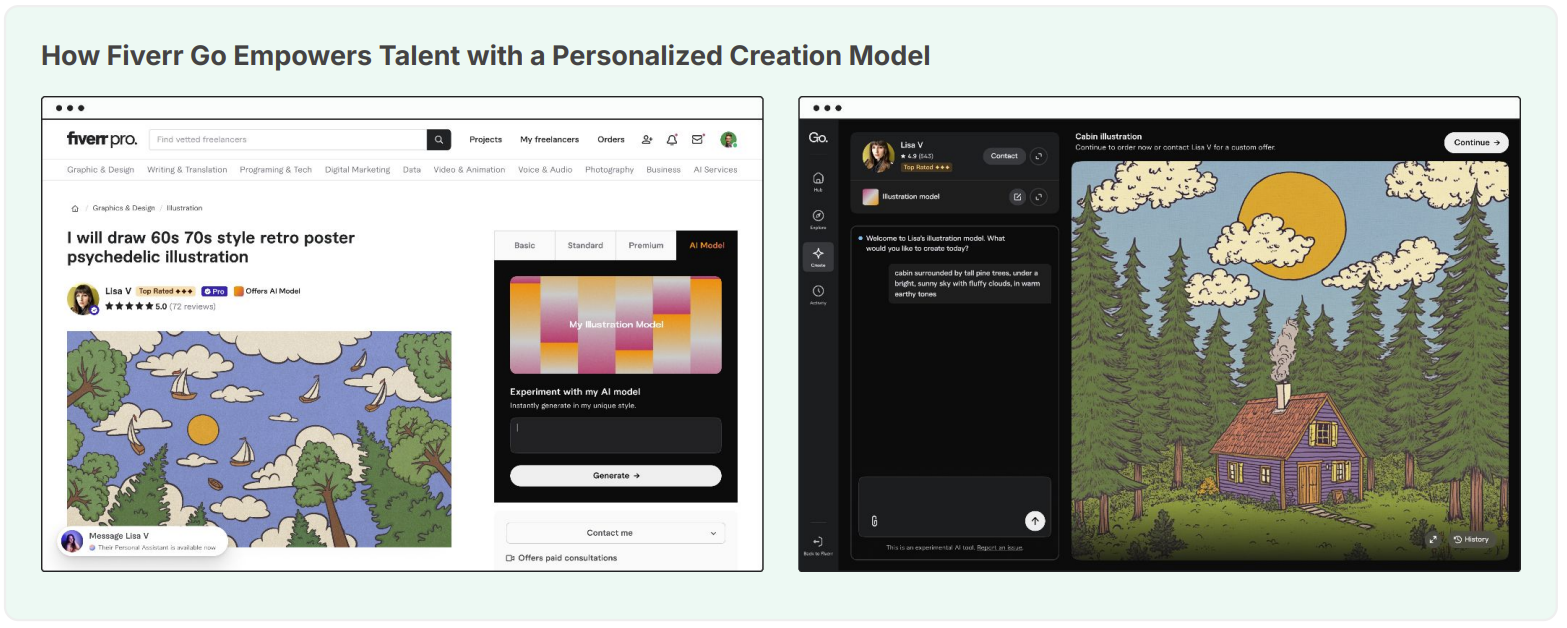For Fiverr, artificial intelligence isn't about replacing creative labor. The plan is to meld digital and human labor in a way that's not zero sum.
Fiverr, a marketplace for freelancers, launched Fiverr Go, an AI platform that enables creators to tune models based on their portfolio of work. The idea behind Fiverr Go is to enable creators to use AI to refine workflows and customer experience, and deliver mockups and first drafts based on their style.
The Fiverr take on AI is notable because it is less zero-sum than what's being pitched by most of the tech industry. Let's face it. Technology giants are increasingly talking about digital labor as replacing humans. And if you follow the money--actually it's more like layoffs--human worker concerns about AI are justified.
This AI digital labor game puts a company like Fiverr in a pickle given generative AI can replace freelancers--and the need for its platform. Fiverr CEO Micha Kaufman positioned Fiverr Go this way on the company's fourth quarter earnings conference call:
"Different from other AI platforms that often exploit human creativity without proper attribution or compensation, Fiverr Go is uniquely designed to reshape this power dynamic by giving creators full control over their creative process and rights. It allows freelancers to become a one-person production house, making more money while focusing on the things that matter creating."
With Fiverr Go, freelancers can create personalized AI models without collecting datasets or understanding the engineering. Fiverr's dataset of 6.5 billion interactions and 150 million transactions on its marketplace round out the training.

Kaufman said AI results are generic and hard to edit and many customers are using Fiverr freelancers to refine images and results. "Every delivery on Fiverr Go is backed by the full faith of the creator behind it, with an included revision as the freelancer defines. This means that the quality and service you get from Fiverr Go is no different from a direct order from the freelancers themselves," said Kaufman.
Fiverr Go's Personalized AI Assistant can communicate with potential clients and handle routine tasks. The Fiverr Go AI Creation Model can create mockups and first drafts based on the freelancer's work. Kaufman said the company also launched a Freelancer Equity Program that will give shares of Fiverr to top-performing freelancers.
The bet is that Fiverr Go, which launched with 60 categories, can convert sales faster for freelancers. The personal AI assistant "is essentially encapsulating the entire knowledge of the freelancer and basing itself on it being able to address any possible question and bring it to conversion," said Kaufman.
In addition, the AI creation model "allows customers to get the confidence that this is the freelancer, this is the style that they're looking for" without the back-and-forth of delivering samples and essentially working for free, said Kaufman.
The Fiverr Go experiment is one worth watching.
Fiverr's outlook
Fiverr said it is expecting to grow revenue at double-digit rates in 2025 with sales of $422 million to $438 million, up 8% to 12%. For the first quarter, Fiverr projected revenue of $103.5 million to $108.5 million.
Kaufman said Fiverr has services revenue momentum going into the first quarter.
For the fourth quarter, Fiverr reported net income of $12.8 million, or 33 cents a share, on revenue of $103.7 million, up 13.3% from a year ago. Marketplace revenue was down 4% from a year ago with 3.6 million active buyers at the end of 2024, down from 4 million a year ago.
For 2024, Fiverr reported net income of $18.2 million, or 48 cents a share, on revenue of $391.5 million, up 8.3% from 2023.
More on digital labor:
- Anthropic's Economic Index highlights AI augmenting mid-to-high salary jobs
- Workday aims to be system of record for AI agents, digital labor
- Agentic AI without process optimization, orchestration will flop
- CxOs upbeat on economy, plan to invest heavily on genAI, AI agents
- Agentic AI: Three themes to watch for 2025


